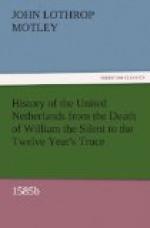By presenting in their natural groupings various distinct occurrences, rather than by detailing them in strict chronological order, a clearer view of the whole picture will be furnished than could be done by intermingling personages, transactions, and scenery, according to the arbitrary command of Time alone.
The Netherlands, by the death of Orange, had been left without a head. On the other hand, the Spanish party had never been so fortunate in their chief at any period since the destiny of the two nations had been blended with each other. Alexander Farnese, Prince of Parma, was a general and a politician, whose character had been steadily ripening since he came into the command of the country. He was now thirty-seven years of age—with the experience of a sexagenarian. No longer the impetuous, arbitrary, hot-headed youth, whose intelligence and courage hardly atoned for his insolent manner and stormy career, he had become pensive, modest, almost gentle. His genius was rapid in conception, patient in combination, fertile in expedients, adamantine in the endurance or suffering; for never did a heroic general and a noble army of veterans manifest more military virtue in the support of an infamous cause than did Parma and his handful of Italians and Spaniards. That which they considered to be their duty they performed. The work before them they did with all their might.
Alexander had vanquished the rebellion in the Celtic provinces, by the masterly diplomacy and liberal bribery which have been related in a former work. Artois, Hainault, Douay, Orchies, with the rich cities of Lille, Tournay, Valenciennes, Arras, and other important places, were now the property of Philip. These unhappy and misguided lands, however, were already reaping the reward of their treason. Beggared, trampled upon, plundered, despised, they were at once the prey of the Spaniards, and the cause that their sister-states, which still held out, were placed in more desperate condition than ever. They were also, even in their abject plight, made still more forlorn by the forays of Balagny, who continued in command of Cambray. Catharine de’ Medici claimed that city as her property, by will of the Duke of Anjou. A strange title—founded upon the treason and cowardice of her favourite son—but one which, for a time, was made good by the possession maintained by Balagny. That usurper meantime, with a shrewd eye to his own interests, pronounced the truce of Cambray, which was soon afterwards arranged, from year to year, by permission of Philip, as a “most excellent milch-cow;” and he continued to fill his pails at the expense of the “reconciled” provinces, till they were thoroughly exhausted.




